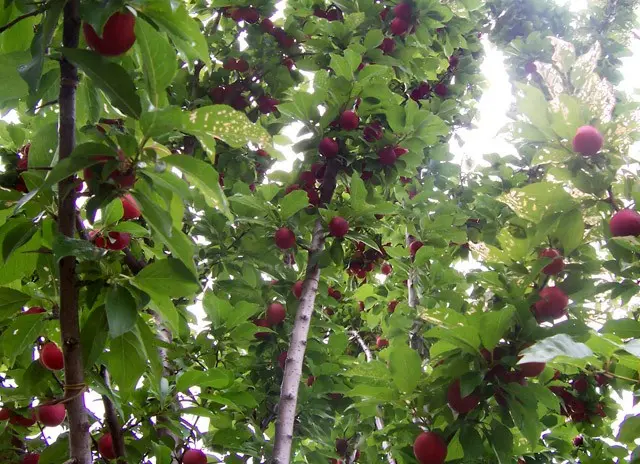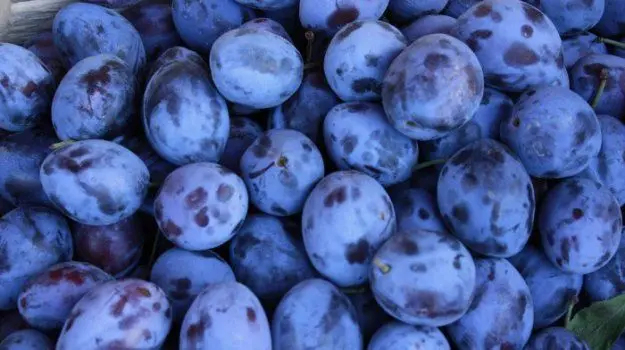Contents


To get a good harvest of plums, they need to be properly looked after. And it’s not just about fertilizing, pruning and watering. There are many pests that are also not averse to eating sweet fruits or tree leaves. Below we will tell you how to deal with the most common pests of fruit crops in the garden.
Fruit mites
Reproduction of fruit mites falls on the summer months. In nature, there are many varieties of these micro insects, but plums are most often affected by red mites. During the season they give from 4 to 8 generations. Each female is able to lay up to 100 eggs. Eggs should be looked for on the veins of the leaves from the inside. During the winter, ticks lay their eggs on the bark. Therefore, in winter, red masonry can be seen on the trees. These insects suck the juices from the leaves. Fruits also suffer from fluid loss. They become lethargic and small.

To combat adults, special insecticide preparations are used. Processing is carried out by Danadim, Fufanon, Fitoverm. These funds should be used at the time of the greatest birth of larvae. If the infection is quite serious, pay attention to the preparations Sunmite, Nissoran, Apollo, Omite. Pyrethroid agents for the fight against red ticks are not used. To prevent attacks of fruit mites, it is important to carry out the procedure for removing the old bark and spring whitewash.
pollinated aphid
These little green insects can give you a lot of trouble and deprive your plum crop. Aphid eggs overwinter on the tree. In the spring, founders appear from them, who are engaged in reproduction and breeding of the colony. Aphids parasitize more often on leaves, but can also reach fruits. The aphid delivers a double blow to the plum. Insects suck out life-giving juices, and after themselves leave sugary secretions, which form a favorable environment for the development of fungi.

It is important to carry out any treatments aimed at combating pollinated aphids in early spring, before flowers and buds begin to bloom on the trees. A 2% nitrafen emulsion or a 1% DNOC solution is suitable for this. If repeated treatments are necessary, after bud break, the crown is sprayed with an oil emulsion of DDT, and after flowering, Karbofos can be used.
moths
The moth is a brown butterfly that lays eggs with caterpillars on plums. The larvae feed on buds and leaves. With a massive infection, the tree can be severely damaged. Since the caterpillars pupate in the ground or in the thickness of fallen leaves, the main method of dealing with them is considered to be digging near the tree trunks in spring and harvesting dry carrion in autumn. Chemical insecticides are used in the mass colonization of caterpillars on branches. If there are more than 4-5 of them per 1 meter of a branch, then the time has come for radical measures.
Video “Urea spraying”
Fruit trees
Codling moths are considered one of the most common plum pests. The greatest danger to gardeners is the larvae of these gray-brown butterflies. When the worms emerge from the eggs, they rush to the fruits and settle inside them. If the bone is not yet ripe, then the larvae get to the very core. If it has already hardened, then the parasites eat away the pulp around it. In this case, the voids are filled with excrement of pests. You can understand that an uninvited guest has appeared inside the plum by a small hole with a cobweb.
Most measures to combat these parasites are preventive in nature. It is important to remove the old bark from the trees in time and allow the fallen leaves to collect around the trunk. You also need to carry out autumn digging and pruning of shoots. During the fruiting period, it is necessary to regularly collect carrion. If the codling moth did appear on your site, you should pay attention to professional insecticides. Processing is carried out in the spring with the help of Karbofos and Akteliki.
pachyderm
Most of all, this insect is common in the forest-steppe zones of Our Country. Mature pachypods begin their destructive activity in the spring, about a week after plum blossoms.
Females lay one egg for each ovary of the fetus. The larvae hatch after about 3 weeks and gnaw a tunnel right into the still soft bone. Adult larvae grow up to 6 millimeters in length and completely incinerate the bone from the inside. Such a fruit loses its vitality and falls prematurely. It becomes impossible to eat it.

The most common and safest method of struggle is to bury the affected fruits. Plums with worms are collected and buried in the ground to a depth of more than 10 centimeters. In such conditions, the larvae cannot pupate and get out. The insecticides listed above are used in cases where the damage to the tree is more than 10%.
Video “Spraying trees in spring”
What to do to keep the trees in the garden healthy and prolific? The following video will help protect them from pests.
Author: Svetlana Galitsina
Loading…









